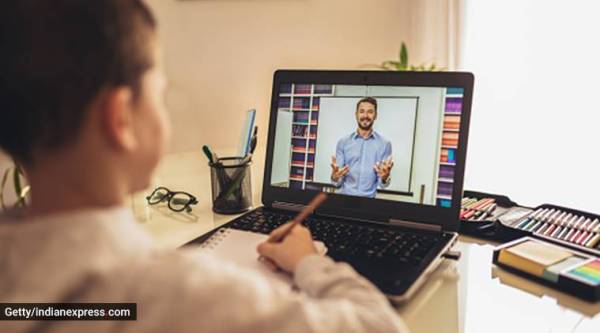 Teachers and principals alike are struggling to uphold the mandate issued by the MHRD in the city. (Source: getty images)
Teachers and principals alike are struggling to uphold the mandate issued by the MHRD in the city. (Source: getty images)
As students, teachers and parents alike scramble to adapt to virtual classes in the new normal, many are experiencing the fallouts of digital fatigue.
In conversation with The Indian Express, students from Chandigarh explained the ways in which digital classes are affecting their daily wellbeing, while teachers and educators state that they are constantly evolving their pedagogical practices to deliver their best through the digital medium.
“Our teachers are very responsive and constantly seek feedback, but just sitting in front of a laptop for six to seven hours a day, even though we get breaks in between, is very draining. It is hard to focus, our eyes hurt and I have frequent headaches,” says a student of class 11 from Strawberry Fields High School.
The student adds that her class hours have been shortened in the past few days, but she still struggles to concentrate while engaged with the virtual medium.
“There is just something about a classroom which is so much more wholesome and at the end of the day you sometimes miss that environment. Even though we are just sitting at home, when my classes finish at one thirty, I just am left with no energy for much else,” says the student.
Keeping in mind the impact on students’ physical and mental health due to increasingly long hours of screen time, the MHRD released new guidelines mandating that only two virtual classes of 30 to 45 minutes each be held for students up till class eighth, and four classes of maximum one-hour length for students between class 9 to 12. However, teachers and principals alike are struggling to uphold this mandate in the city.
“We also get virtual fatigue and want to shorten the classes, but then we have to become digitally literate enough to figure out different ways of educating beyond just live streaming what we would do in a usual class. It is a big challenge for us teachers as well, as we spend time beyond the class hours looking up material online as well,” says an English teacher from a private school in the city.
Another student from Vivek High School, explains how she is fatigued after sitting in front of a screen from 8.45 am to 2.15 pm. “On a typical day we have three, or maximum four classes now and we also get breaks in between. But even in those breaks we can’t really do anything else so it does become quite draining,” says the class 11 student.
“During physical classes, interaction between students and teachers is way easier than this. And not as isolating as it is in the online medium,” adds the student.
Diksha Suri, a parent and educator from the city, says that all stakeholders need to adapt to the varied tools available for digital education.
“This is an opportunity to figure out different ways of teaching and learning but unfortunately most teachers and schools are not equipped to completely and seamlessly transfer to the virtual space right now,” says Suri.
She adds that her students have also complained of the toll virtual classes take on them. As a parent, she is worried about the distractions the digital medium provides.
“But no one in particular is to blame for this. Teachers and schools are under pressure from parents who believe that sending quizzes and other interactive material is not good enough and teachers need to be present in person all the time. And now if teachers extend their classes, then the issue will be continuous exposure to the screen without limited engagement. So, the digital medium needs to be used more dynamically by all, and not just to stream lectures,” says Suri.